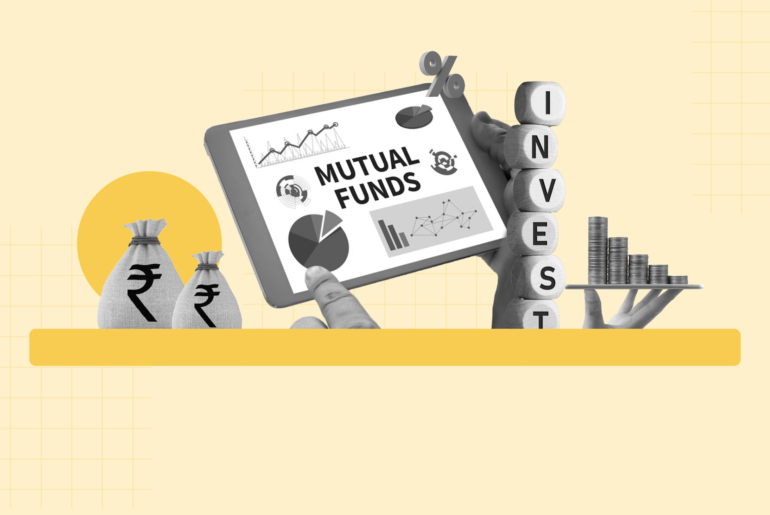Last Updated on May 25, 2022 by Neera Bhardwaj
The investment world offers investors a plethora of options and opportunities to grow wealth. A popular investment vehicle is bond funds. These funds are a kind of mutual fund that largely invests in fixed income securities like government and corporate bonds. But what are bond funds? How are they different from bonds? Is there any risk involved? Let us find out.
Table of Contents
What is a bond fund?
A bond fund is a debt fund that invests 80% of its portfolio in different kinds of bonds like government securities and corporate bonds. It is a pooled investment with the convenience of professional selection and portfolio management. Some portion of the portfolio can be invested in the money market, generally, to meet the liquidity requirements.
The portfolio is sufficiently diversified to minimize credit risk. Its structure diversifies risk inexpensively. With bond funds, investors have the opportunity to collect interest income, dividends, and long-term capital gains (LTCG), or reinvest them back into the fund to increase the principal amount that will earn interest.
Understanding bonds funds
Following enumerated features will help you have a clear understanding of bond funds:
- Since a bond fund is a mix of bonds, the principal amount may fluctuate in these funds from time to time and the interest distribution may also vary every month.
- Bond funds are managed by fund managers and an investment team who buy and sell bonds according to market conditions and the objectives of the fund. There is no compulsion for them to hold the bonds till maturity.
- That said, the maturity period of the underlying assets is constant, therefore, there are high chances that the interest rate risk does not increase and remains constant throughout the investment.
- You can sell bond funds whenever you want for their prevalent market net asset value (NAV) that brings capital gain or loss. Note that a fund’s NAV fluctuates in response to interest rates, credit quality, currency values, and overall cash flows of bond funds.
- Many investors find a bond fund more efficient than individual bond securities as it provides instant diversification with minimum investment apart from liquidity.
- Long-term investors who want to refrain from higher levels of risk prefer these funds.
Who should invest in bond funds?
Investors with a low-risk profile who want regular returns but without equity exposure generally prefer to invest in bond funds. You can purchase bond funds if you prefer stable returns over possible but uncertain capital appreciation in the equity market.
The measure of bond fund performance
The performance of a bond fund, like all funds, depends on its underlying assets. There are certain other factors too, that affect its performance. The past performance of a fund is not a guarantee for future results.
Share price: Every fund has a NAV which represents the value of one share of the fund that fluctuates daily.
Yield: The yield is the income generated by the underlying bonds in the fund. Based on the 30-day annualized yield, one can check the fund’s average yield to know the yield potential of the fund.
Bonds vs. bond funds
Bond funds differ from individual bonds in several ways. Have a look at this table for a better understanding.
| Bonds | Bond Funds | |
| Maturity Date | Defined | Undefined |
| Redemption | At par on maturity | At current NAV |
| Variables Affecting Investment | – Interest rate risk reduces as the bond maturity date is near – Affected hugely from default | – Constant interest rate risk – The lesser impact from the default |
| Liquidity | Only high quality and popular bonds are easy to liquidate | Generally highly liquid |
| Fees | Commission added to the cost of purchase | Annual management fees and sales commission |
| Types | Vary by issuer, maturity, credit quality, interest rate | Dynamic bond Funds, Income funds, term-based, strategy or investment objective-based, etc. |
Why do investors prefer bond funds?
Easier to invest
Most investors find bond funds attractive investment options as these are easier to invest in than individual bonds. You get professional assistance from portfolio managers.
Liquidity
Bond funds offer high liquidity. However, a fund’s liquidity is affected by supply and demand, and the credit of the fund company.
Easy accessibility
You can buy bond funds directly from the fund company through brokers or banks. You can do this via unit investment trusts, open-end funds, closed-end funds, ETFs (exchange-traded funds), and money market funds.
Quick diversification
Since bond funds are diversified investments with a pool of different bonds, they minimize the risk involved. Even if one or two bonds do not perform well, your monthly interest from the fund does not get impacted hugely.
Cost-efficiency
A bond fund results in cost efficiency as an investor only pays the annual expense ratio that includes marketing cost, administrative cost, and professional management fees.
Risks associated with bond funds
Interest rate risk
Bond price and interest rate carry an inverse relationship. If there is an increase in interest rate, bond prices in the open market reduce, and if interest rates decline, bond prices increase. To understand this relationship, you can see that the longer the maturity period, the higher the interest rate risk because its net asset value (NAV) reacts greatly to the change in prices of the underlying bonds.
Credit risk
A bond fund can be of medium-to-high credit quality or low-investment-grade quality, based on the underlying bonds in the fund. Rating agencies rate these bonds to help investors in identifying the issuer’s creditworthiness. You can find many fund managers investing in high-yield bond funds that are lower-quality bonds. Therefore, bond funds are subject to credit risk.
Principal risk
You sell your share in a bond fund at the fund’s current NAV. NAV is determined by dividing the total value of all holdings in the fund by the number of fund shares. If the fund’s NAV was higher on the day you bought it than its current NAV, you would be at a loss of some of your initial investment.
Conclusion
Investing in bond funds can offer better liquidity, diversification and cost-efficiency. A bond fund that largely invests in government securities, debentures, and corporate bonds can effectively hedge your portfolio against market risks besides offering stable returns. Talk to your financial advisor before investing in an investment vehicle.
Before ending this article, we’ve got a special surprise for you! On account of Diwali 2021, we are gifting you a free Tickertape PRO upgrade! Just sign up on Tickertape and avail the offer.
Go on, claim your free account now!




